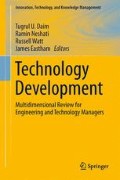Abstract
The problems in generation imbalance for wind power require multi-criteria analysis for the decision makers. In addition to the required multi-criteria analysis, there is also a problem of uncertainty inherent in future changes as a result of interdependence among these criteria. To counter this two problems, this paper describes a systematic approach of Bayesian causal maps and systematic probability generation method. Bayesian causal maps, which is built from causal maps, is used to develop a proposed framework on scenario-based assessment of energy storage technologies for wind power generation. Causal maps provides a rich representation of ideas, through the modeling of complex structures, representing the chain of arguments, as networks.
A prior version of this paper was included in the conference Proceedings of PICMET 2013.
Access this chapter
Tax calculation will be finalised at checkout
Purchases are for personal use only
References
Liu Z (2001) Causation, Bayesian networks, and cognitive maps. Zidonghua Xuebao/Acta Autom Sin 27(4):552–566
Eden C (2004) Analyzing cognitive maps to help structure issues or problems. Eur J Oper Res 159(3):673–686
Nadkarni S (2001) A Bayesian network approach to making inferences in causal maps. Eur J Oper Res 128(3):479–498
Watthayu W, Peng Y (2004) A Bayesian network based framework for multi-criteria decision making. Proceedings of the 17th international conference on multiple criteria decision analysis, pp. 6–11
Spiegelhalter DJ, Dawid AP, Lauritzen SL, Cowell RG (1993) Bayesian analysis in expert systems. Stat Sci 8(3):219–241
Nadkarni S (2004) A causal mapping approach to constructing Bayesian networks. Decis Support Syst 38(2):259–281
Sahin S, Ulengin F, Ulengin B (2006) A Bayesian causal map for inflation analysis: the case of Turkey. Eur J Oper Res 175(2):1268–1284
Lazzerini B, Mkrtchyan L (2010) Risk analysis using extended fuzzy cognitive maps. 2010 international conference on intelligent computing and cognitive informatics. pp. 179–182
Montibeller G, Belton V (2006) Causal maps and the evaluation of decision options—a review. J Oper Res Soc 57(7):779–791
Eden C, Ackermann F, Cropper S (1992) The analysis of cause maps. J Manag Stud 29(3):309–324
Siau K, Tan X (2005) Improving the quality of conceptual modeling using cognitive mapping techniques. Data Knowl Eng 55(3):343–365
Kosko B (1986) Fuzzy cognitive maps. Int J Man-Machine Stud 24:65–75
Huang Y, Ni L, Miao Y (2009) A quantum cognitive map model. 2009 fifth international conference on natural computation. pp. 28–31
Pearl J (1988) Probabilistic reasoning in intelligent systems: networks of plausible inference. Morgan Kaufmann, San Francisco, CA, 552
Nilsson NJ (1996) Artificial intelligence: a modern approach. Artif Intell 82(1–2):369–380
Neapolitan RE (2009) Chapter 5—Foundations of Bayesian networks. In: Probabilistic methods for bioinformatics: with an introduction to Bayesian networks. Morgan Kaufmann, Burlington, MA
Norsys Software Corp (2011) Netica™ application. pp. 85–133
Mortensen EN (2006) Real-time semi-automatic segmentation using a Bayesian network. In: 2006 IEEE computer society conference on computer vision and pattern recognition, vol. 1 (CVPR’06). pp. 1007–1014
Doong SH, Shu-Chun Ho (2011) Construct a sequential decision-making model: a dynamic Bayesian network perspective. Proceedings of the 44th Hawaii international conference on system sciences. pp. 1–10
Zeng Y, Xiang Y, Pacekajus S (2008) Refinement of Bayesian network structures upon New Data.pdf. 2008 IEEE international conference on granular computing, GRC 2008. pp. 772–777
Jingjing L, Yan P, Ting Z (2008) The application of Bayesian network in the performance evaluation and decision-making system. 2008 IEEE international conference on networking, sensing and control. pp. 180–183
Thibault G, Bonnevay S, Aussem A (2007) Learning Bayesian network structures by estimation of distribution algorithms: an experimental analysis. 2007 2nd international conference on digital information management. pp. 127–132
Alpaydin E (2004) Introduction to machine learning (Adaptive computation and machine learning), vol. 5, no. August. The MIT Press, Cambridge, MA, pp 233–237
Changliang X, Zhanfeng S (2009) Wind energy in China: current scenario and future perspectives. Renew Sustain Energy Rev 13(8):1966–1974
Trucco P (2008) A Bayesian belief network modelling of organisational factors in risk analysis: a case study in maritime transportation. Reliab Eng Syst Safe 93(6):845–856
Lemmer JF, Gossink DE (2004) Recursive noisy OR—a rule for estimating complex probabilistic interactions. IEEE Trans Syst Man Cybernet B 34(6):2252–2261
Monti S, Carenini G (2000) Dealing with the expert inconsistency in probability elicitation. IEEE 12(4):499–508
Chin K-S, Tang D-W, Yang J-B, Wong SY, Wang H (2009) Assessing new product development project risk by Bayesian network with a systematic probability generation methodology. Expert Syst Appl 36(6):9879–9890
Kim JH, Pearl J (1983) A computational model for combined causal and diagnostic reasoning in inference systems. Proceedings of the eighth international joint conference on artificial intelligence. pp. 380–385
Heckerman D (1999) A tutorial on learning with Bayesian Networks. In: Learning in graphical models. MIT Press, Cambridge, MA, pp 301–354
Daim T, Kayakutlu G, Suharto Y, Bayram Y (2010) Clean energy investment scenarios using the Bayesian network. Int J Sustain Energy(November):1–16
Daim TU, Suharto Y (2012) Storage technology portfolio for integrating wind power generation storage technology portfolio for integrating wind power generation. In: Encyclopedia of energy engineering and technology. Taylor and Francis, New York, NY, pp 1–9
Daim U, Li X, Kim J, Simms S (2013) Evaluation of energy storage technologies for integration with renewable electricity: quantifying expert opinions. Environ Innovation Soc Transitions 3:29–49
Author information
Authors and Affiliations
Corresponding author
Editor information
Editors and Affiliations
Rights and permissions
Copyright information
© 2014 Springer International Publishing Switzerland
About this chapter
Cite this chapter
Suharto, Y., Daim, T.U. (2014). Technology Assessment: Energy Storage Technologies for Wind Power Generation. In: Daim, T., Neshati, R., Watt, R., Eastham, J. (eds) Technology Development. Innovation, Technology, and Knowledge Management. Springer, Cham. https://doi.org/10.1007/978-3-319-05651-7_5
Download citation
DOI: https://doi.org/10.1007/978-3-319-05651-7_5
Published:
Publisher Name: Springer, Cham
Print ISBN: 978-3-319-05650-0
Online ISBN: 978-3-319-05651-7
eBook Packages: Business and EconomicsBusiness and Management (R0)

